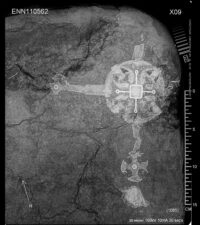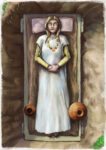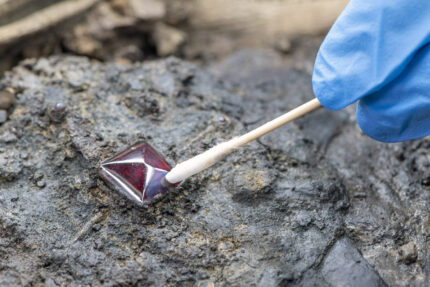Museum of London Archaeology (MOLA) archaeologists have revealed a large garnet at the center of the silver cross from the exceptionally wealthy 7th century bed burial found at Harpole, Northamptonshire, England.
Discovered last April, the burial of an elite Saxon-era woman contained an ornate necklace with an unprecedented number of pendants made of garnets, semi-precious stones, Roman gold coins (all from the reign of Theodosius I, 379-395 A.D.) and glass pendants separated by gold wire spacer beads. The necklace is the largest, finest and most ornate example of its kind.
Another uniquely large and elaborate artifact was found on the torso of the deceased. It was removed in a soil block to be excavated in a conservation laboratory. An X-ray of the soil block revealed it contained a huge silver cross mounted on wood. The cross is too big to have been worn as a jewel. It may have been meant to be carried in processions or used as a devotional object on an altar.
 The cross is a foot long from top to bottom and is adorned with more crosses. There are Canterbury crosses 4 cm (1.6 inches) wide at the end of the cross-arms arm and the bottom of the descending arm. At the center point of the crossarm is an equal-armed cross 8 cm (3.15 inches) wide. Between each of the arms of the central cross are oval human faces cast in silver with blue glass eyes.
The cross is a foot long from top to bottom and is adorned with more crosses. There are Canterbury crosses 4 cm (1.6 inches) wide at the end of the cross-arms arm and the bottom of the descending arm. At the center point of the crossarm is an equal-armed cross 8 cm (3.15 inches) wide. Between each of the arms of the central cross are oval human faces cast in silver with blue glass eyes.
MOLA conservators are currently micro-excavating the soil block, using the X-ray as a guide map. While the arms are still encased in soil, the square stone at the center has now been exposed. It is a pyramid square cabochon garnet and judging from the photograph, it is in excellent condition.
 The burial dates to between 630 and 670 A.D. At that time, Harpole was part of the Kingdom of Mercia which was smack in the middle of converting to Christianity. The first introduction of Christianity to Mercia came in 628 when the pagan King Penda conquered Christian Saxon-held territories. Penda’s son Peada sealed the deal in 655 when he converted to Christianity and agreed to evangelize and convert his subjects as a condition of his marriage to Alchflaed, the daughter of King Oswiu of Northumbria.
The burial dates to between 630 and 670 A.D. At that time, Harpole was part of the Kingdom of Mercia which was smack in the middle of converting to Christianity. The first introduction of Christianity to Mercia came in 628 when the pagan King Penda conquered Christian Saxon-held territories. Penda’s son Peada sealed the deal in 655 when he converted to Christianity and agreed to evangelize and convert his subjects as a condition of his marriage to Alchflaed, the daughter of King Oswiu of Northumbria.
The woman buried in this grave had to have been Christian and someone of very high social status to boot. The size of the cross suggests she may have been a religious leader.
